Do you think your chest workout routine should focus exclusively on the bench press? Think again.
While the bench press is a popular exercise, but there are many other exercises that can help build your chest.
From bodyweight moves to dumbbell variations, you’ll find new ways to work your pecs for strong growth and a great physique.
To achieve a well-rounded, sculpted chest, you must train from various angles, targeting the upper, lower, inner, and outer pectorals.
Let Know How.
In this blog, we will provide an in-depth overview of the following topics:
- Best Chest Exercises For Men
- Pro-Tips and Techniques
- How to Train Your Chest Muscles for Mass
- Chest Workout Routines
- Anatomy of the Chest Muscles…. For Deeper INSIGHTS

- 10 Best Chest Exercises For Men To Build Mass
- 1. Barbell Bench Press
- 2. Dumbbell Bench Press
- 3. Incline Bench Press
- 4. Decline Bench Press
- 5. Dumbbell Fly
- 6. Chest Dip
- 7. Push-Ups
- 8. Dumbbell Pullover
- 9. Cable Crossover
- 10. Machine Chest Press
- Bonus: Machine Fly
- How to Train Your Chest Muscles For Mass
- 1. Optimize for Weekly Chest Training Volume
- 2. Select Your Chest Workout Routine As Per Your Goal
- 3. Must Do Compound Chest Exercises
- 4. Add Isolation Chest Exercises
- 5. Progressively Load The Chest Muscles
- 6. Focus On Adequate Rest and Recovery
- 7. Do Warm-Up Exercises Before Chest
- How To Progress Your Chest Workout Routine
- Men’s Chest Workout Routines To Build Mass
- Beginner Chest Workout Routine
- For Intermediate
- Advance Chest Workout Routine
- Chest Pumped Workout
- Know More About Chest Muscles
- Pectoralis Major
- Pectoralis Minor
- FAQs
- How many chest exercises per workout
- How many sets and reps should I do for chest exercises?
- How often should I train my chest muscles?
- Can I train my chest every day?
- Takeaways
10 Best Chest Exercises For Men To Build Mass
The chest exercises for men are divided into pressing, machine, cable, chest fly-type, push-up, dip, and pullover exercises.
Here are the 10 best chest exercises that help build a massive and well-shaped chest.
1. Barbell Bench Press
The Bench Press is one of the best chest muscle-building exercises. This exercise should be the center of all your barbell chest workouts.
The flat barbell press, also known as the bench press, is a popular compound exercise that targets the chest, triceps, and shoulders.
The Flat Barbell Chest Press is a fundamental exercise for the upper body and should be part of any good chest exercise regime. That’s why it always remains at the top of the list for overall chest development.
Barbell Bench Press Variations for Chest Growth:
- Incline Barbell Bench Press: Mainly targets the upper chest muscles.
- Decline Barbell Bench Press: Mainly targets the lower chest muscles.
- Close-Grip Bench Press: Mainly targets the triceps muscles more than the chest.
- Reverse Grip Bench Press: focuses most on the upper pecs and tricep.
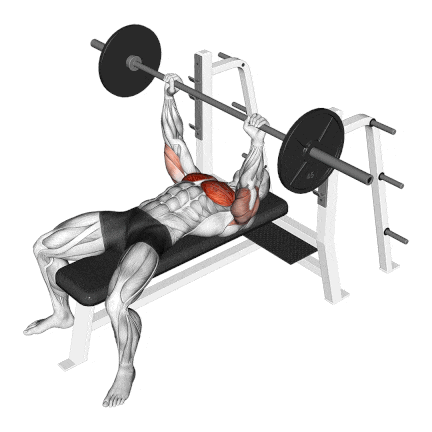
How To Do
- Lie flat on a bench with your feet on the ground and your eyes directly underneath the barbell.
- Grab the barbell with a grip that is slightly wider than shoulder-width apart.
- Lift the barbell off the rack and lower it towards your chest in a controlled manner.
- Press the barbell back up towards the starting position until your arms are nearly locked out.
- Repeat for the desired number of repetitions.
Tips
- Keep a controlled motion and avoid jerky movements.
- Do not bounce the weights off the chest.
- Avoid too much arching of the back.
- For heavyweights, use a spotter.
- Keep your elbows tucked in towards your body as you lower the barbell to your chest.
2. Dumbbell Bench Press
The barbell bench press has a limitation that it does not involve the full range of motion, a limitation the dumbbell bench press overcomes.
The dumbbell chest press is a popular exercise for building upper body strength and developing the chest muscles. It is a compound exercise that works for multiple muscle groups at once.
They provide an extra range of motion at the top for complete chest development. Furthermore, dumbbells demand better coordination, forcing the stabilizing muscles to assist as well.
The studies suggest that barbell and dumbbell bench presses can be used interchangeably for chest development without reducing muscle activation or negative transfer effects.
Other Variations of Dumbbell Chest Press:
- Incline Dumbbell Chest Press: Targets the upper chest muscles.
- Decline Dumbbell Chest Press: Targets the lower chest muscles.
- Neutral-Grip Dumbbell Chest Press: Targets the chest muscles while reducing shoulder stress.
- Alternating Dumbbell Chest Press: This involves alternating each arm during the press, which can improve stability and balance.
- Single-arm dumbbell bench press: helps improve unilateral strength and balance in the chest.
How To Do
- Lie flat on the bench, keeping your feet on the floor for better balance, with a dumbbell in each hand.
- Hold the Dumbbells straight overhead, palms facing forward.
- Now, lower the weights to your outer chest, stretching the chest to the maximum at the bottom.
- Now, raise it until your arms are nearly locked out, keeping the dumbbells very close together.
- Repeat for the desired number of repetitions.
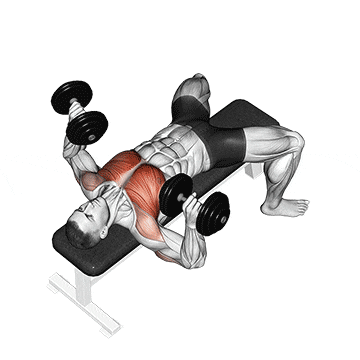
Tips
- Keep a controlled motion, and avoid jerky movements.
- Keep your feet planted on the ground throughout the exercise.
- Keep your elbows at a 45-degree angle to your body as you lower the dumbbells.
- Make sure to maintain a stable, flat back throughout the exercise.
Note: Variations in chest workouts, such as substituting barbell bench presses for dumbbell bench presses or vice versa, could benefit experienced lifters who have developed efficient techniques.
Know More: 10 Best Chest Workout With Dumbbells
3. Incline Bench Press
The incline bench press is an effective exercise for targeting the upper chest muscles, which can help create a more defined and aesthetically pleasing chest shape.
It is one of the best exercises for building muscle mass in the upper and middle pectoral regions. Moreover, it can improve shoulder and tricep strength, which can be used in other upper-body exercises.
According to EMG results, some benches have a steep incline that works the front delts as much as the chest. To target the upper pecs specifically, opting for a lower incline, such as 30 degrees, is recommended.
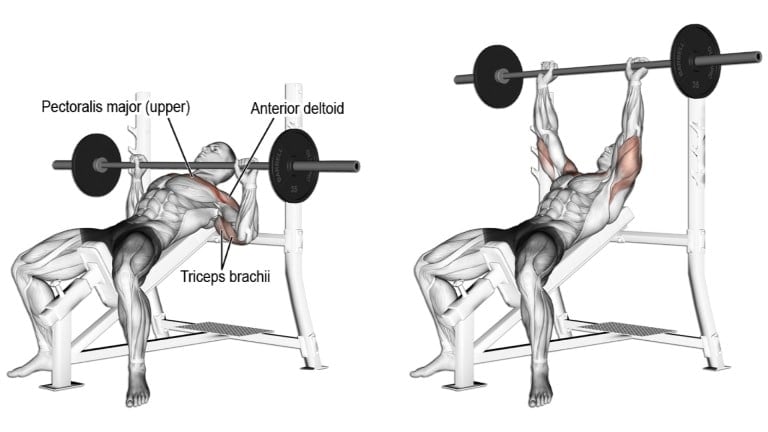
Variations of Incline Bench Press to Stimulate Chest Growth
- Dumbbell Incline Bench Press: Allow a greater range of motion.
- Close-Grip Incline Bench Press: hands closer together on the barbell, which targets the triceps more than the chest.
- Incline Barbell Reverse Grip Bench Press: Using a reverse grip on the barbell targets the upper chest muscles
- The Smith Machine Incline Bench Press: Provide additional stability and control during the movement.
- The Incline Hammer Dumbbell Press: Provide a unique range of motion that emphasizes the upper chest muscles.
How To Do
- Set the bench to a slight incline (30-45 degrees).
- Lie down on the bench with your feet flat on the ground and your back flat against the bench.
- Grasp the barbell with an overhand grip, hands slightly wider than shoulder-width apart.
- Unrack the weight and lower it down to your upper chest, keeping your elbows at a 45-degree angle to your body.
- Press the weight back up to the starting position and breathe out as you lift.
- Repeat for the desired number of repetitions.

Tips
- Keep your elbows at a 45-degree angle to your body to target the upper chest muscles.
- Perform press in a controlled manner.
- Use a bench inclined at 30–45 degrees to focus on the chest muscles, avoiding a more upright position that shifts the stress to the shoulders.
- Keep your feet planted on the ground throughout the exercise.
4. Decline Bench Press
The decline barbell bench press is a variation of the traditional barbell bench press, where the bench is set to a declined position.
The angle of the adjustable bench in this variation puts more tension on your lower chest muscles than a flat bench press would. It’s also important to correct the bench angle to hit the lower chest the most.
Know the BEST Angle.
Research indicates that the correct angle for the decline bench press should be 15–30 degrees, declining from flat to target the lower chest. Most standard decline benches offer adjustable angles in this range.

Decline Bench Press Variations for Chest Growth:
- Close-grip decline bench press
- Reverse-grip decline bench press
- Decline dumbbell press
- Decline Smith machine press
How To Do
- Set the decline bench at a decline of around 15–30 degrees.
- Lie down on the bench with your feet firmly placed on the foot pads.
- Ensure your hands are shoulder-width apart when grabbing the barbell with an overhand grip.
- Lower the barbell or dumbbells slowly towards your lower chest.
- Once the barbell reaches your chest, pause for a brief moment.
- Push the barbell back until your arms are fully extended, but don’t lock your elbows.
- Repeat the exercise for the desired number of repetitions.
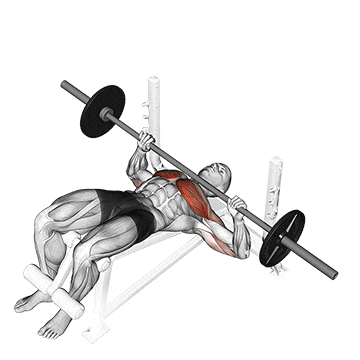
Tips
- Keep a controlled motion and avoid jerky movements
- Use a spotter when lifting heavy weights.
- Keep your back flat against the bench throughout the exercise.
- Avoid arching your back or lifting your hips off the bench.
- Exhale as you push the weight up, and inhale as you lower it down.
5. Dumbbell Fly
The dumbbell fly is an isolation exercise that is usually performed after big compound lifts like the bench press and incline press.
It is considered to be the perfect finishing move and a great way to focus on your chest after many pressing exercises.
The chest fly requires little equipment. If you don’t have a bench, you can do dumbbell flies while lying on the floor.
The fly is often considered a classic body-building movement. The goal of the exercise is to isolate the chest for aesthetic purposes.
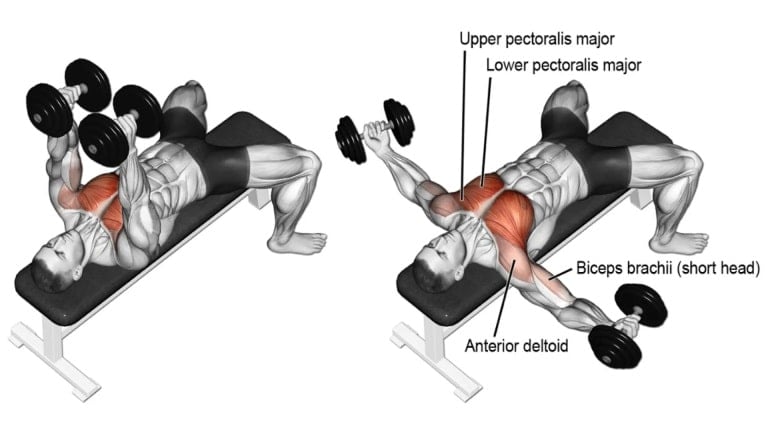
Different Fly Exercises to Develop Your Chest
- Standing Dumbbell Fly
- Decline Dumbbell Fly
- Decline Cable Fly
- Incline Cable Fly
- Incline Dumbbell Chest Fly
- Low To High Cable Fly
- High To Low Cable Fly
How To Do
- Lie on the flat bench with your feet flat on the floor.
- Lift your arms straight up from your shoulders and the dumbbells directly over your upper chest.
- Slowly lower your arms to your sides until your wrists reach about shoulder level or slightly above.
- Bring your arms back toward the midline of your body, focusing on using your pec muscles to draw them back together.
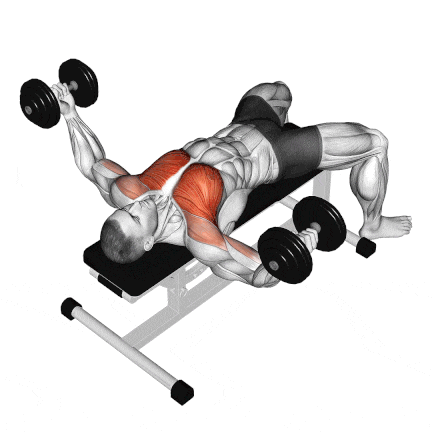
Tips
- Don’t let your elbows drop too far when you’re in the start position, they should remain in line with your torso when you’re lying on the bench.
- Don’t let the dumbbells touch as they meet at the top, holding for a second in the contracted position.
- Make sure you keep your elbows bent.
Read More To Know More: Cable Fly: Muscle Worked, Alternate, Variations
6. Chest Dip
Chest dip is a compound exercise that targets the chest, triceps, and shoulders. It involves using parallel bars to support your body weight while dipping.
Since it targets multiple muscle groups simultaneously, it is an effective exercise for building upper body strength and mass. It also increases upper body stability and coordination.
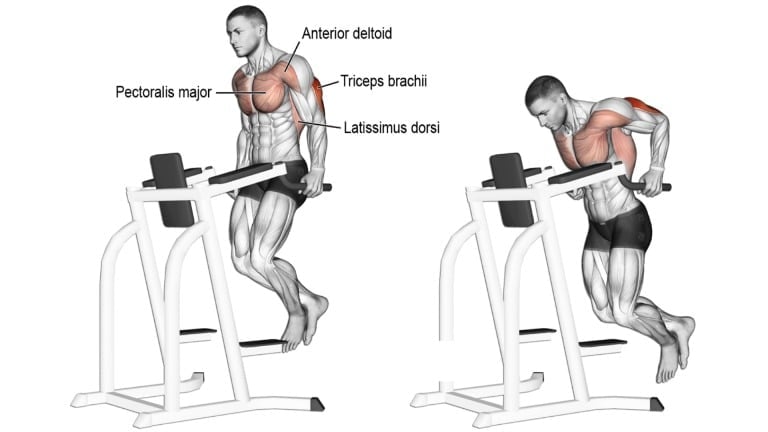
Chest Dip Variations For Strength and Stability
- Weighted dips: Hold a weight plate or dumbbell between your feet or with a weight belt.
- Chest-focused dips: Tilt your torso forward further than usual, emphasizing your chest muscles.
- Triceps-focused dips: Keep your torso more upright to emphasize your triceps muscles.
- Machine-assisted dip: help beginners to execute the exercise with correct form and develop strength.
- Ring dip: It is common in gymnastics training and CrossFit workouts
How To Do
- Grab the parallel bars firmly and raise yourself at arm’s length.
- Lean forward slightly and lower your body, keeping your elbows tucked in and your shoulders down.
- Continue to dip until your shoulders are just below your elbows or until you feel a stretch in your chest.
- Push back up until your arms are straight, but don’t lock your elbows.
- Do 8-10 reps and 3-4 sets
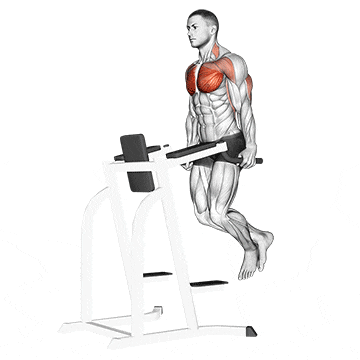
Tips
- Hold a dumbbell between your legs if you need additional resistance.
- Keep your torso slightly forward to emphasize your chest muscles.
- Focus on keeping your elbows close to your sides to target your triceps.
- Avoid dipping too low, which could cause injury to your shoulders.
Know More: Bodyweight Chest Exercises: Beginner To Advance
7. Push-Ups
Push-ups can be performed regardless of where you are, and, best of all, they are free—no expensive equipment or annual gym fees are required. There are different types of push-up variations to meet different needs.
The classic push-up has survived the test of time and is the single most efficient exercise for simultaneously strengthening the chest, arms, deltoid, lower back, abs, and glutes.
Push-ups are one of the most basic but rewarding exercises, and everyone from teenagers to older adults can benefit from doing them regularly.

Different Push-Up For a Complete Chest Workout.
- Wall Push-ups and knee push ups are the best type of push ups for beginners.
- Standard push ups are best for strengthening the chest, shoulders, and triceps.
- Incline Push Up works your lower chest and back more.
- Decline push-up works the upper chest and front shoulders
- Close grip and diamond Push ups focus more on the tricep and inner chest than the shoulder.
- Wide grip push-ups focus more on the outer chest and shoulder.
- Reverse Type Push up is considered the bicep push-up.
- Pike Push-ups focus more on shoulder than chest and tricep.
- Hindu push-up works from your whole body, from upper to lower body; it works from your front to back.
- Single-Leg Push Up, One Arm Push-Up and Clapping Push-Up Types of push-up are best for advanced athletes.
How To Do
- Lay face down on the ground with your legs straight and arms supporting your upper body.
- Keep your knees off the ground.
- Raise yourself off the ground, straightening your elbows and your arms.
- Now, lower your body under slow, sustained motion, feeling the motion all the way down until your chest is very close to the ground.
- Raise until your elbows are locked, and pause momentarily at the top of the movement.
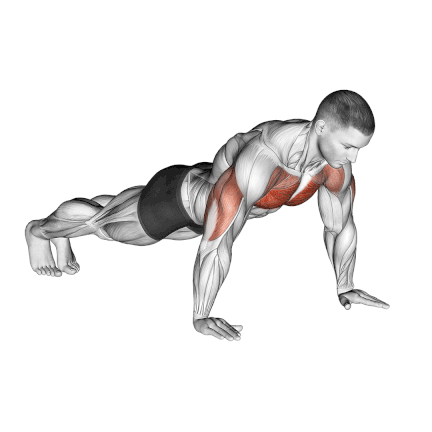
Tips
- Keep your elbows close to your body.
- For additional variations, you can do incline chest push-ups and decline push-ups.
8. Dumbbell Pullover
The classic dumbbell pullover is a widely used resistance exercise that primarily strengthens the muscles in the chest and back.
It also engages the large wing-shaped muscles in the back (latissimus dorsi), the core muscles, and the triceps.
It involves lying down on a bench and moving a dumbbell over your head while maintaining a slight bend in your elbows. They are an excellent addition to your upper body strength routine.
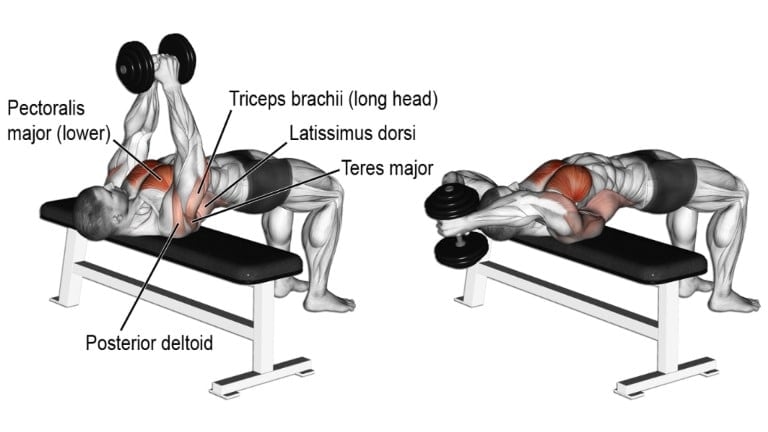
Different Pull-over Exercises That Help to Grow Chest
- Barbell pullover
- Cable Pullover
- Incline pullover
- Decline pullover
- Swiss ball dumbbell pullover
How To Do
- Lie across on a bench on your shoulders so that your head is hanging.
- Grasp a dumbbell with both hands and get it straight over your chest.
- Lower the dumbbell in an arc slowly, getting a good stretch in your rib cage.
- Lower the dumbbell as far as possible and then raise it back to the starting position.
- Repeat for your desired number of reps.

Tips
- Exhale while you exert.
- Maximum stretching ensures the greatest expansion of the rib cage.
- Use a weight that challenges you but allows you to maintain proper form.
- Relax your hips and let them fall, as relaxed hips help in extra expansion.
- Keep your core tight and your lower back flat against the bench.
9. Cable Crossover
The Cable Crossover is a resistance training exercise primarily targeting the chest muscles. The exercise involves using cable machines to perform a fly-like motion with the arms, crossing them in front of the body.
Standing Cable Crossovers exercise helps to develop and define Inner chest muscles.
The cable provides constant resistance, and helps in developing central chest muscles, and provides the much-needed stress on inner pecs.
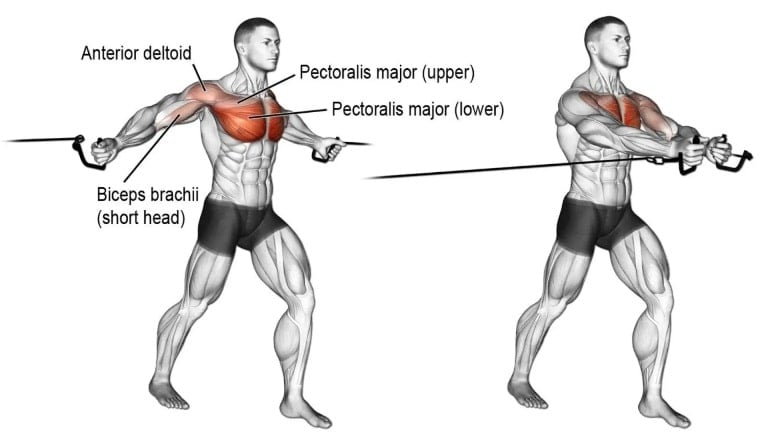
Variations of Cable Crossover
- High Cable Crossover: Set the cables to a high position to target the lower chest muscles
- Low Cable Crossover: Set the cables low to target the upper chest muscles.
- Single-Arm Cable Crossover: Perform the exercise one arm at a time to increase stability and engage the core muscles.
- Reverse Cable Crossover: Start with the arms crossed in front of the body. It engages the rear deltoids and upper back muscles.
How To Do
- Start by setting the cable machines to the desired height and weight.
- Stand between the two cable machines and grasp the handles.
- Step forward with one foot and lean slightly forward at the hips.
- Keeping the arms straight but not locked, bring the handles together in front of the body, crossing them at the wrists.
- Slowly lower the arms back to the starting position, maintaining control and tension in the chest muscles.

Tip
- Keep the core engaged and the back straight.
- Avoid arching the back or rounding the shoulders.
- Use a weight that allows for proper form and controlled movements.
- Adjust the height of the cable machines to target different areas of the chest.
Know More: 14 Best Cable Chest Exercises
10. Machine Chest Press
A machine chest press is a resistance exercise in which you push a weight away from your body using a machine with a chest press attachment.
According to EMG research, the machine bench press involves the shoulders to a lesser extent than free-weight alternatives. This means you can focus more on working your chest muscles.
The machine allows you to isolate and target the chest muscles while providing support and stability. Several types of chest press machines are available, including plate-loaded and cable machines.
Using a machine can benefit beginners or those with difficulty with free weights, providing stability and reducing the risk of injury.
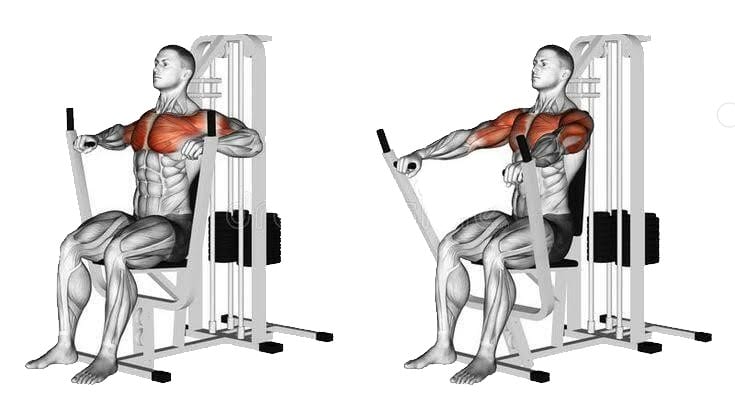
Variations of Machine Press for Building Chest Muscles
- Close grip machine chest press
- Reverse grip chest press
- Incline machine press
- Lying machine chest press
How To Do
- Adjust the machine’s seat so that the handles are at chest level.
- Sit on the machine with your back flat against the backrest and your feet flat on the floor.
- Grasp the handles with an overhand grip and press them away from your body until your arms are fully extended.
- Slowly bring the handles back towards your chest, keeping your elbows tucked in and your wrists straight.

Tips
- Keep your shoulders back and down to prevent them from hunching forward.
- Exhale as you push the handles away from your body, and inhale as you bring them back towards your chest.
- Start with a light weight and gradually increase the resistance as you get stronger.
Bonus: Machine Fly
The machine fly is an effective exercise for building chest muscles. It isolates and targets the pectoral muscles, while providing stability to the shoulders. Unlike some chest exercises, the machine fly provides stability to the shoulders and reduces stress on the rotator cuffs.
The machine fly is a safe and easy exercise to perform, making it suitable for beginners and those with shoulder injuries.
EMG data shows that machine fly and bench press both activate the pectoralis major muscle similarly, making them both effective exercises for chest growth. Unlike the bench press, the machine fly does not require a spotter, allowing you to push the intensity and reach muscle failure safely.

Machine Fly Variations:
- Reverse fly
- One-arm fly
- Standing fly:
How To Do
- Adjust the seat and handles to ensure that your arms are at shoulder height and your elbows are slightly bent.
- Position yourself: Sit down on the machine with your back flat against the backrest and your feet firmly on the ground.
- Grasp the handles with an overhand grip and keep your wrists straight.
- Bring the handles together in front of your chest in a smooth and controlled motion.
- Hold for a second at the top of the movement, and then slowly return to the starting position.
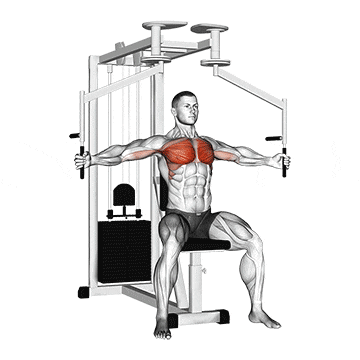
Tips
- Your upper arms should be parallel to the floor.
- Keep your eyes straight ahead while performing the exercise.
- Keep your elbows slightly bent.
- Avoid using momentum to bring the handles together. Instead, use a slow and controlled motion to target the chest muscles.
- Inhale as you bring the handles together, and exhale as you return to the starting position.
How to Train Your Chest Muscles For Mass
1. Optimize for Weekly Chest Training Volume
The training volume or number of repetitions (reps) and sets you perform for chest exercises will depend on your fitness goals and current fitness level.
Here are some general guidelines:
- Beginners: ~10 sets per week.
- Intermediate: ~15 sets per week.
- Advanced: ~20 sets per week.
When a certain amount of volume stops being effective and your progress stalls, you can add sets to increase volume and use that as a driver of renewed progress.
2. Select Your Chest Workout Routine As Per Your Goal
- For muscle endurance: Do 3–4 sets of 12–15 reps with moderate resistance.
- For muscle strength: Do 3–5 sets of 6–10 reps with more resistance.
- For muscle hypertrophy (increased muscle size): Aim for 3–4 sets of 8–12 reps, with a moderate to heavy amount of resistance.
It is always best to start with fewer reps and sets and gradually increase them as your strength improves.
Furthermore, it is important to allow for adequate rest between sets, typically 60–90 seconds.
3. Must Do Compound Chest Exercises
Compound chest exercises use multiple muscle groups to perform the movement. They target the chest muscles and involve other muscle groups, such as the shoulders, triceps, and back.
Compound exercises are generally more effective for building overall strength and mass.
- Barbell Bench Press (Flat, Incline, Decline)
- Dumbbell Bench Press (Flat, Incline, Decline)
- Dips (Chest-focused variations)
- Push-ups (Wide variations hit the chest well)
4. Add Isolation Chest Exercises
Isolation chest exercises, on the other hand, target the chest muscles specifically. These exercises are useful for targeting specific chest areas and improving muscle definition.
- Cable Flyes (High, Low, Mid-level)
- Dumbbell Flyes
- Machine Flyes / Pec Deck
- Dumbbell Pullovers
5. Progressively Load The Chest Muscles
Progressive overload is the gradual increase in stress placed on the muscles during strength training over time.
As the muscles adapt to the current workload, you must continually increase the demands to keep challenging them and promoting further muscle growth.
How to do it:
- Increase weight: As you get stronger, add a little more weight to your lifts.
- Increase volume: Do more sets or reps with the same weight.
- Increase intensity: Shorten rest times, try harder exercise variations, or use advanced techniques.
6. Focus On Adequate Rest and Recovery
Building a bigger chest isn’t just about crushing weights. It’s also about giving your muscles the rest they need to grow. Here’s the truth: muscle growth happens during recovery, not while you’re lifting.
Aim for 36–48 hours of rest before training your chest again. Pushing it too often can lead to overtraining, which is the opposite of what you want. It stalls progress and makes recovery harder.
When you rest, your muscles repair microtears. This rebuilding process makes them stronger and bigger. Resting helps your batteries recharge, and your brain recovers, preparing you for your next chest workout.
7. Do Warm-Up Exercises Before Chest
Do you think warm-ups are a waste of time? Think again. A good warm-up is like prepping the canvas before you create a masterpiece.
Here’s why it matters for your chest workouts:
- Increases blood flow to the muscles.
- Raises the body temperature and improves muscle flexibility.
- Enhances mental focus and attention.
- Reduces the risk of injury by preparing the body for exercise.
Spend 5–10 minutes warming up before hitting the bench. Here are some quick and effective options:
- Cardio: Light jog, jumping jacks, cycling.
- Dynamic Stretches: Arm circles, torso twists, arm swings.
- Light Resistance: Push-ups (even modified on your knees), light-weight chest flies.
How To Progress Your Chest Workout Routine
As we already discussed, it is crucial to progress your chest workout routine to avoid plateaus and continuous growth. Although everyone’s journey is unique, several factors determine when it’s time to switch things up.
- The 4-8 Week Rule: Generally, it is best to follow a specific program or routine for 4–8 weeks before considering a change. This time frame lets your body adjust to the stimuli.
- Time to Switch Things Up: If you can’t increase the weight or reps, it’s a sign that your body has adapted to the chest workout routine and that a change is needed.
- Beginner Lifters: If you’re new to lifting weights, don’t change your chest workout too quickly.. Your body is in its prime growth phase – those first few months are magical. Stick to a basic chest workout routine for at least 4 months. You’ll be amazed at how quickly your chest transforms.
- Incorporate Periodization: Implementing periodization, or planned variation in training variables like volume, intensity, and exercise selection, can facilitate long-term progression. Cycling through different training phases (e.g., hypertrophy, strength, power) every 6–12 weeks is an effective strategy.
- Deload to Reload: Every 4-8 weeks, schedule a lighter “deload” week. Cut your volume and weights in half. This sounds counterintuitive, but it helps your body recover and prepares it to push harder in the next phase.
- Evaluate Your Recovery: If you constantly feel fatigued, sore, or unable to recover properly between workouts, then it may be time to adjust your routine. Now, focus more on recovery.
Men’s Chest Workout Routines To Build Mass
Ready to unlock serious chest gains? This mass-building workout routine will take your chest workout to the next level.
Beginner Chest Workout Routine
Here is a beginner bodyweight chest workout routine that can be done at home:
| Exercise | Reps | Sets | Rest |
|---|---|---|---|
| Push ups | 10–12 reps | 3 sets | 90 seconds |
| Dumbbell Bench press | 8–10 reps | 3–4 sets | 90 seconds |
| Incline Bench Press | 8–10 reps | 3 sets | 90 seconds |
| Dumbbell fly | 10–12 reps | 3 sets | 90 seconds |
For Intermediate
| Exercise | Reps | Sets | Rest |
|---|---|---|---|
| Barbell Bench Press | 10–12 reps | 3–4 sets | 60–90 seconds |
| Decline Dumbbell Press | 8–10 reps | 3–4 sets | 60–90 seconds |
| Chest Dips | 10–12 reps | 3 sets | 60–90 seconds |
| Machine Fly | 10–12 reps | 3 sets | 60–90 seconds |
Advance Chest Workout Routine
| Exercise | Reps | Sets | Rest |
|---|---|---|---|
| Barbell Bench Press | 6–8 reps | 3–4 sets | 60 seconds |
| Incline Dumbbell Press | 8–10 reps | 3–4 sets | 60 seconds |
| Decline Barbell Press | 10–12 reps | 3 sets | 60 seconds |
| Weighted chest Dips | 8–10 reps | 3–4 sets | 60 seconds |
| Clapping Push Up | 10–12 reps | 3 sets | 60 seconds |
Chest Pumped Workout
Looking for a pumped chest? Try this workout routine that features high reps and short rest periods. You’ll be able to lift heavy weights and push yourself to failure.
For an added challenge, incorporate drop sets. Get ready to leave the gym with a tight shirt.
| Exercise | Sets | Reps | Rest |
|---|---|---|---|
| Barbell Bench Press | 4 | 12-15 | 60 seconds |
| Incline Dumbbell Press | 3 | 15-20 | 45 seconds |
| Cable Flyes | 3 | 15-20 | 45 seconds |
| Push-ups (weighted if possible) | 3 | failure | 30–45 seconds |
Know More About Chest Muscles
The chest muscles consist of the pectoralis major and the pectoralis minor.
The pectoral major may be referred to as “pecs,” “pectoral muscle,” or “chest muscle” because it is the largest and most superficial muscle in the chest area.

Pectoralis Major
The pectoralis major is the most superficial muscle in the pectoral region.
The pectoralis major itself comprises two heads, each of which may be worked differently depending on the angle of adduction:
- An upward angle of movement emphasizes the upper or clavicular head,
- While a lower angle emphasizes the lower or sternal head of the muscle.
The function of the pectoralis major is 3-fold dependent on which head of muscles are involved.
- Flexion, adduction, and medial rotation of the arm at the glenohumeral joint
- The clavicular head causes flexion of the extended arm
- The sternoclavicular head causes extension of the flexed arm
Pectoralis Minor
The triangle-shaped muscle is located under the pectoralis major, a layer deeper, and draws the shoulder blades down and forward.
FAQs
How many chest exercises per workout
- Beginners should do 2-3 chest exercises per week. (~10 sets)
- Intermediate should do 3-4 chest exercises per week. (~15 sets)
- Advanced should do 5-6 chest exercises per week. (~20 sets)
How many sets and reps should I do for chest exercises?
Doing 3–4 sets of 8–12 reps for chest exercises is recommended. The specific number of sets and reps can vary depending on individual goals, fitness levels, and exercise selection.
How often should I train my chest muscles?
You should train your chest muscles 1–2 times per week, with at least 48 hours of rest between workouts. This allows for proper muscle recovery and growth.
Can I train my chest every day?
It is not recommended to train the chest muscles every day. Muscles need time to recover and repair after a workout; overtraining can lead to injury and stalled progress.
To allow for proper recovery, it’s best to give your chest muscles at least 48 hours of rest between workouts.
Takeaways
Okay, let’s be honest – we all want a strong-looking chest. But chest workouts do more than make you look good. They can actually make you stronger and help you torch that stubborn chest fat.
Plus, there are so many great chest exercises, so you’ll never get bored, and your muscles will always be challenged.
The key to achieving hypertrophy (building muscle) with exercises is maximizing tension and time under tension.
Try a chest-focused workout to see how you feel when you put all this into action. Change up the exercises, play with the weights, and find what works best for YOUR body.
I’d love to hear how your chest training is going and answer any questions you might have.
References
- Schoenfeld, B. J., Ogborn, D., & Krieger, J. W. (2017). Dose-response relationship between weekly resistance training volume and increases in muscle mass: A systematic review and meta-analysis. Journal of sports sciences, 35(11), 1073–1082.
- Ralston GW, Kilgore L, Wyatt FB, Baker JS. The Effect of Weekly Set Volume on Strength Gain: A Meta-Analysis. Sports Med. 2017 Dec;47(12):2585-2601. doi: 10.1007/s40279-017-0762-7. PMID: 28755103; PMCID: PMC5684266.
- Int J Environ Res Public Health. 2020 Oct 8;17(19):7339. Effect of Five Bench Inclinations on the Electromyographic Activity of the Pectoralis Major, Anterior Deltoid, and Triceps Brachii during the Bench Press Exercise.
- Comparative Study Eur J Sport Sci. 2016;16(3):309-16. Epub 2015 Mar 23. Influence of bench angle on upper extremity muscular activation during bench press exercise.
- Hrysomallis C. Effectiveness of strengthening and stretching exercises for the postural correction of abducted scapulae: a review. The Journal of Strength and Conditioning Research. 2010;24(2):567-574.
- Padkao T, Boonla O. Relationships between respiratory muscle strength, chest wall expansion, and functional capacity in healthy nonsmokers. Journal of Exercise Rehabilitation. 2020;16(2):189-196.

Manish brings over 10 years of hands-on experience in weight lifting and fat loss to fitness coaching. He specializes in gym-based training and has a lot of knowledge about exercise, lifting technique, biomechanics, and more.
Through “Fit Life Regime,” he generously shares the insights he’s gained over a decade in the field. His goal is to equip others with the knowledge to start their own fitness journey.
